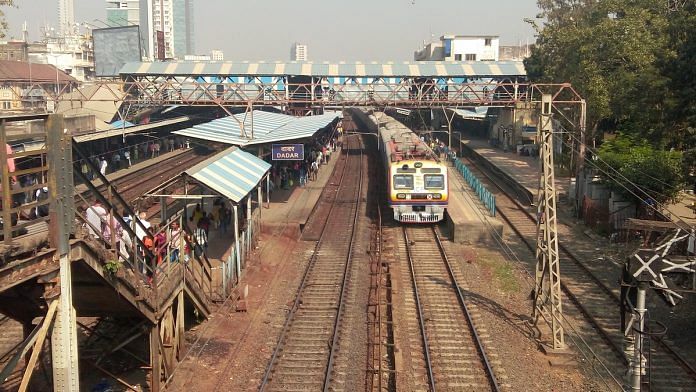New Delhi: Days after pulling up the Railways for its claim of zero deaths so far in the 2020-21 fiscal year, the NITI Aayog has asked the Railways to install automatic doors on all suburban trains, including in the infamously crowded local trains in Mumbai, ThePrint has learnt.
At a meeting on 18 August, under the chairmanship of NITI Aayog CEO Amitabh Kant, the government think-tank asked the Railways to ensure that all suburban trains have automatic doors in an attempt to curb deaths that occur due to overcrowding as doors are usually open.
According to the minutes of the meeting, accessed by ThePrint, the NITI Aayog told the Railways, “Automatic doors must be installed on all suburban trains. Railways may also consider installation of platform screen doors (PSDs) on the platforms especially in high density sub-urban stations.”
PSDs are glass-made screens meant to enhance passenger safety, which are installed on the edge of railway platforms. They open only when a train arrives and remain shut after it departs.
Suburban trains in India run in Mumbai, Chennai, Kolkata, Hyderabad and Delhi.
ThePrint sent queries to the railway ministry spokesperson via a text message on the proposal’s feasibility, but there was no reply.
Also read: Begging on trains could soon be decriminalised as railways ministry reviews redundant laws
NITI Aayog questioned Railways’ ‘zero deaths’ claim
The suggestion was made in a meeting held weeks after Kant, in a letter, to the Railway Board Chairman, questioned the Railways on its claim of zero deaths.
In his letter dated 24 July, Kant had said almost 2,000 people lost their lives in the Mumbai suburban network every year, and that figure ought to be factored in while reporting fatalities.
Referring to a presentation made by the Railways, Kant said, “The presentation made highlights, a total of five deaths recorded in 2019-20 and zero deaths in the current fiscal year. Is this a realistic record?”
“In Mumbai’s suburban network itself, over 2,000 people lose their lives every year. It was informed that these deaths are caused on account of trespassing and are therefore not counted,” he said. “I would like to draw your attention to the fact that many of these deaths are caused by people falling overboard or from the platform onto the tracks.”
Railway officials flag concerns with suggestion
Railway officials, meanwhile, welcomed the Niti Aayog proposal but said there are at least three problems with it.
Firstly, having open trains with manual doors allows for ventilation in the overcrowded trains. In fact, responding to a Public Interest Litigation (PIL) filed in the Madras High Court to install automatic doors, the Southern Railways had told the court in 2018 that the idea was not feasible on account of the ventilation question.
“The climate of all suburban sections in India is hot and humid. The comfort level of passengers is already poor in EMU/suburban trains due to the presence of a large number of passengers (more than the permissible capacity) inside a coach. It results in causing poor ventilation and high carbon dioxide level inside a closed coach,” a deputy chief electrical engineer (Operations & Electric Multiple Unit) had said.
Secondly, having automatic doors would reduce the capacity of these trains significantly. “It would be safe to say that at least 10-15 per cent of the passengers would not be able to get accommodated if the doors are shut,” said a railway official. “How will they travel? Do you have the bandwidth to increase the trains running to accommodate all of them?”
The third issue flows from the second, as another official said having automatic doors increase the halt time by at least 30 seconds. This would increase the headway time between the running of two trains in Mumbai from three to at least five-six minutes. Given that the Mumbai locals are already saturated — with almost 3,000 train services a day — the time cost may also be an impediment for the Railways, the official said.
Also read: All-powerful CEO, end to department culture — How Railways restructure will reshape it







If u people have really worked on it u should know about how this city works itss polulatiion. Why waste money instead of upgrading track frequecy of train or tracking the commuters route of crowding on some major stations or even a parallel train route
Why not change them into metro trains? A costly proposal but very much required for improving safety. For this , need dedicated tracks separate from main lines and new plate forms. Locals are obsolete thing. So phase them out. Borrow from world bank to do so or do commercial development on station properties.